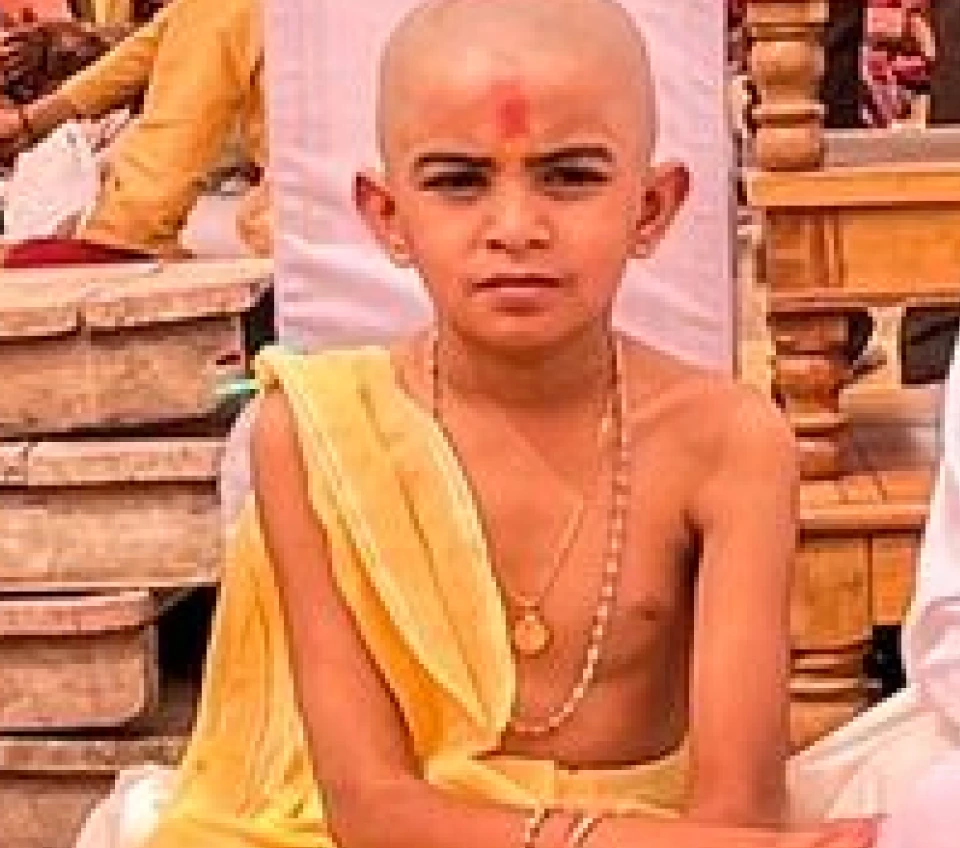We are
Sompura Tirth Purohit
About Us
The Sompura Brahmins, also known as Somvanshi, trace their lineage back to the Vedic era. The Vedic mantra “इमन्देवा असपत्न्या” states “सोमोस्माकं ब्राह्मणानां राजा” which means that the moon god is the king of our Brahmin lineage. Although we may not have physically come from the moon, our ancestors hailed from the land where the moon held its influence. In Vedic culture, the moon is associated with the origin of herbs, which have a purifying effect on the internal organs and mechanisms of the body. It is believed that the people from the land influenced by the moon’s energy possessed the purest blood, which we identify as “Aryan blood.”
ॐ इ॒मन्दे॑वा ऽअसुप॒त्न सु॑वध्वम्मह॒ते क्ष॒त्राय॑ मह॒ते ज्यै॑ष्ठ्याय मह॒ते जान॑राज्या॒येन्द्र॑य॑ ।
इ॒मम॒मुष्य॑ पु॒त्रम॒मुष्यै॑ पु॒त्रमस्यै वि॒शऽए॒ष वो॑मी॒ राजा सोमो॒ स्माक॑म्ब्राह्म॒णाना॒ राजा॑ ॥
Our Traditions
We follow our traditons for centuries.

Yagnopavit Sanskar
Vedarambha samskar called Janoi or sacred thread ceremony, is traditional and based upon Vedic texts, mundan (bold head) is essential and Gayatri mantra diksha is performed by seers or gurus. A must see event for those who wants to understand the vedic traditions as it was is till as on date intact.

Palkhi Yatra
Sompura brahmins are celebrating Palkhi Yatra every year in a month of May at Somnath Temple. They do Somnath Mahadev yatra around the somnath town and do the worship.
There are thousands of devotees joins this Palkhi Yatra from around the globe to celebrate and get blessed.

Brahm Bhojan
Brahma bhojan is unique tradition, only dhoti weared people of sompura Brahmin cook and serve foods to caste fellows, caste members also wears traditional dhoti and kurta.

Guru Purnima
The word "Guru" in Sanskrit means "teacher" or "spiritual guide," and "Purnima" refers to the full moon day. Therefore, Guru Purnima is a day dedicated to honouring the role of the guru in one's life and paying respects to them.
It is a traditional Hindu festival celebrated to honor and express gratitude towards spiritual teachers, mentors, and gurus.

Dhuleti
Dhuleti is celebrated with Bhairavnath idol puja and Holika pujan and Dahan. The flag over Holi flies in sky on burning Holi, experts see and forecasts about rain (A total unknown science for rest of world) in communal ground sompuras being gathered to celebrate Holi with natural colours of Kesuda (Butea monosperma flower) and other natural ingredients.

Navratri
Navaratri is a Hindu festival celebrated over nine nights and ten days. The word "Navaratri" is derived from two Sanskrit words: "nava," meaning nine, and "ratri," meaning night. The festival typically occurs in the Hindu calendar month of Ashvin, which falls in September or October in the Gregorian calendar.
Navaratri is dedicated to the worship of the Hindu goddess Durga or Shakti, in her various forms such as Parvati, Lakshmi, and Saraswati.
Origin
Skand Puran
According to their traditions, the Sompura Brahmin are so named because they were created by the god Chandra to perform sacred ceremonies called Som Yajna for the god Shiva. They are concentrated in the town of Prabhas Patan and form one of the oldest Brahmin communities in Gujarat. They speak Gujarati. Skand Puran gives the reference for the creation of Sompura Brahmins wide it’s chapters 21/22/23/24.
Pratishtha Yagya
The Agnihotri brahmins from Chandra Lok came to Prabhas Patan with Hemgarbha-the chief secretary of Moon God to conduct-perform a pratishtha yagya of the first temple of lord Somnath and after the yagya the moon god requested these Brahmins to stay there.
BC
These Brahmins stayed near Somnath so they are called Sompura Brahmins. Generally, the civilisations develop and moves with the source of water worldwide, but the sompura brahmin is the only class who have been stable near Somnath for at least 2000 years.
Sompura Dynasty
In 10th century, some families with children, aged peoples, and pregnant ladies migrated towards Rajasthan, Maharashtra to the South. Rajasthan class vipers adopted temple architecture, they are known as sompura Shilpi, southern class dvijas merging with the local culture but kept samskara of their origin, they are known today as sorarhi brahmins most families are near Madurai Gotras and cultures may varied, historically their root is in sompura dynasty.
 Sompura Brahmins, in Skanda Puran refers as Agnihotri Brahmins of Soma Loka, on request of their king moon came to Prabhas to perform pratishtha yagya of worshipped god named Somnath, later on request of lord moon the Agnihotri Brahmins decided to stay in Prabhas and perform all rituals for devotees, since the days the Brahmins are known as Sompura.
Sompura Brahmins, in Skanda Puran refers as Agnihotri Brahmins of Soma Loka, on request of their king moon came to Prabhas to perform pratishtha yagya of worshipped god named Somnath, later on request of lord moon the Agnihotri Brahmins decided to stay in Prabhas and perform all rituals for devotees, since the days the Brahmins are known as Sompura.©2025 सोमपुरा ब्राह्मण तीर्थ पुरोहित सोमनाथ (SBTPS). All rights reserved. | Design and Developed by bScale.